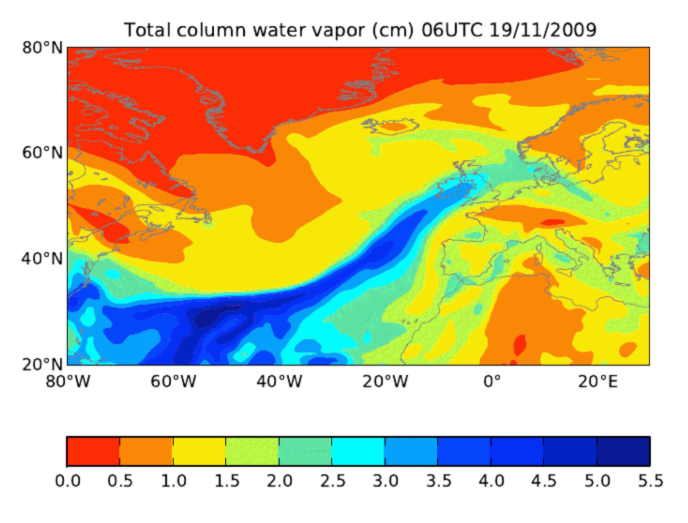Paul Brown of Climate News Network reports on a new study of “atmospheric rivers” – bands of enhanced water vapour in the earth’s atmosphere. The study shows they are becoming bigger and holding more water vapour as the earth’s atmosphere warms.
“Atmospheric rivers”, airborne corridors of concentrated moisture which carry huge volumes of water, are set to get wider and longer, causing more frequent and catastrophic floods as the atmosphere warms.

Atmospheric river affecting 2009 winter flooding in North West England - Image credit: Earth System Research Laboratory,USA
Heavy and prolonged rainfall will cause both more frequent and more severe flooding across the United Kingdom and the rest of north-west Europe as the atmosphere continues to warm, say British and American scientists.
A study in IOP Publishing’s Environmental Research Letters of what are known as atmospheric rivers pins the blame for the increasing flood risk firmly on man-made climate change and says the same problem will afflict other parts of the planet.
Researchers at the University of Reading near London, and the US University of Iowa, describe how atmospheric rivers carry vast amounts of water vapour around the Earth, delivering heavy and prolonged rainfall, particularly to mountainous areas. They were responsible for the protracted winter and summer floods in the UK in 2012, which caused an estimated $1.6 billion (£1 bn) in damage.
In a warming world the atmosphere can carry more water and the research showed that the rivers, typically running a kilometer above the earth, 300 kilometres wide and thousands of kilometres long, would become larger and capable of delivering even bigger quantities of prolonged rainfall.
Longer danger period
An example of their potential danger is the atmospheric river that caused the severe flooding on 19 November 2009 over north-west Britain. As it approached the coast it was transporting a moisture volume 4,500 times the average gauged flow of the river Thames through London.
In California, where atmospheric rivers (ARs) have already been assessed, the climate models predict that the number of years with these features will increase. To discover what could happen in Europe the models were tested against the known flooding events between 1980 and 2005, and the researchers found that they could accurately simulate what actually happened.
This gave them confidence to test what would happen in the future. All the models showed that with more greenhouse gases emitted by humans there would be a doubling of the number of atmospheric rivers later this century compared with the 1980 to 2005 period. Most of these events occur in the winter, but in a warmer world the danger period is extended.
Effects will be widespread
Because of the way the warmer atmosphere is able to carry more water and deliver much higher rainfall totals, the potential for far worse floods from each of these rainfall events is much increased.
The head of the research, Dr David Lavers, from the department of meteorology at the University of Reading, said:
“ARs could become stronger in terms of their moisture transport. In a warming world, atmospheric water vapour content is expected to rise due to an increase in saturation water vapour pressure with air temperature. This is likely to result in increased water vapour transport.
“The link between ARs and flooding is already well established, so an increase in AR frequency is likely to lead to an increased number of heavy winter rainfall events and floods. More intense ARs are likely to lead to higher rainfall totals, and thus larger flood events.”
The paper points out that while the scientists were specifically looking at the atmospheric rivers that caused heavy rainfall in Europe, these storms affect many temperate regions of the planet. As the atmosphere warms, it is likely that they will increase the risk of flooding elsewhere. – Climate News Network
